On a continent filled with natural splendor, the many spectacular waterfalls of South America are a highlight on many visitors’ trips.
Whether it’s a towering cascade or a frozen waterfall you’re after, South America has what you’re looking for.
While we could not possibly include all the waterfalls worthy of mention in this guide, here are my picks of the most magnificent waterfalls in South America.
These go beyond Iguazú Falls and into the realms of lesser-known falls in the continent.
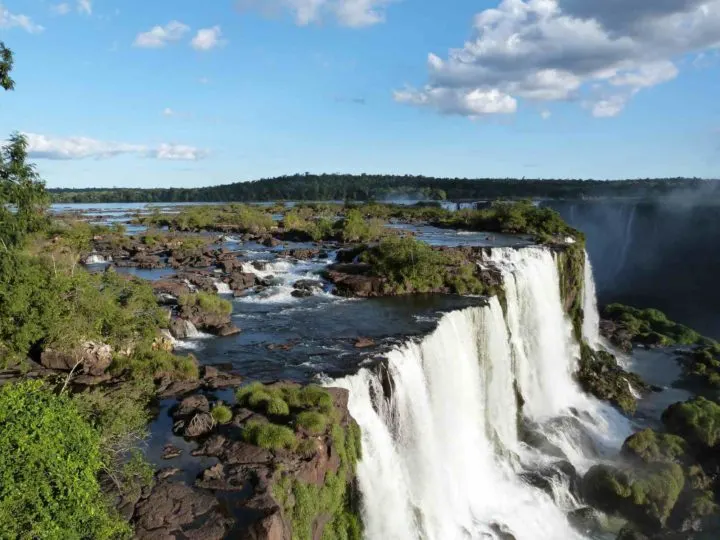
1. Iguazú/Iguaçu Falls
- Height: The longest drop is 82 metres (269 feet).
- Location: On the border between Argentina, Brazil and Paraguay
- Closest city: Foz do Iguaçu (Brazil) and Puerto Iguazú (Argentina)
- Best time to visit: December through February when the volume of water is at its highest.
- How to visit: There are flights to Foz do Iguaçu from multiple cities in Brazil, including Sao Paulo and Rio de Janeiro, and flights from Buenos Aires in Argentina Puerto Iguazú. From both Foz do Iguaçu (Brazil) and Puerto Iguazú, they can be visited by bus.
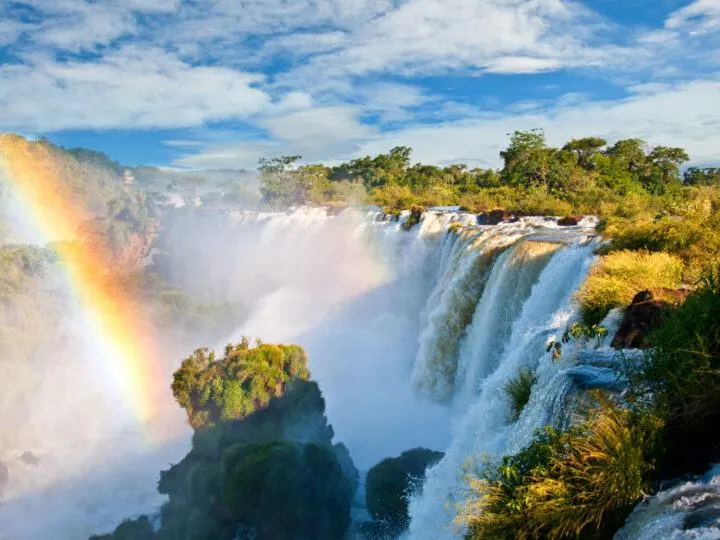
First up on our list is one of the world’s great natural spectacles, Iguazú. Any trip to the region is incomplete without a visit to these massive falls, which are shared between Argentina and Brazil.
Stupendous views await visitors on either side of the river, which is cloven in two by a series of between 150-300 individual cascades (all depending on recent rainfall), which tumble into the deafening Garganta del Diablo (Devil’s Throat) in the river’s centre.
Planning Your Trip to South America?
Save time, stress & money with a customized travel itinerary planned for you by a South America expert
2. Angel Falls
- Height: The longest drop is 807 metres (2648 feet).
- Location: Southeastern Venezuela.
- Closest city: Ciudad Bolívar, Venezuela
- Best time to visit: July through October when the volume of water is at its highest.
- How to visit: Flights from Caracas reach Ciudad Bolivar, from where a motorised canoe or a small aircraft takes travelers to Canaima Camp. From Canaima, it’s a four-hour motor-canoe to the trail and an hour-and-a-half to the viewpoint.
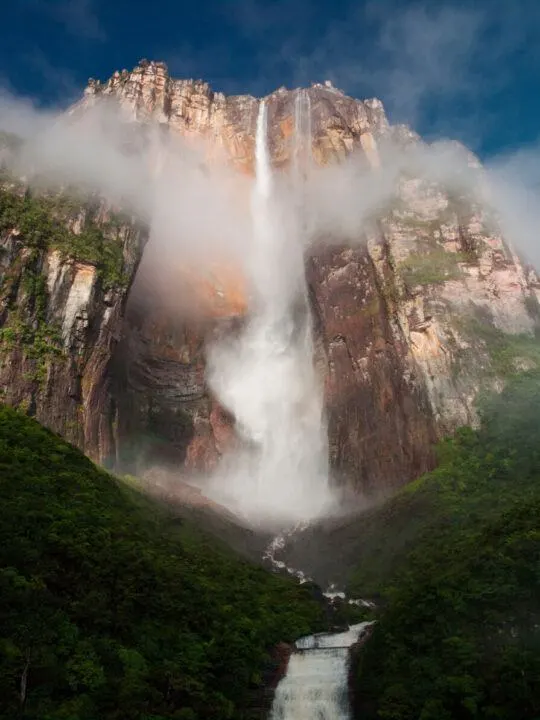
While the panoramic breadth of Iguazú takes the breath away, the sheer vertical drop of Venezuela’s Angel Falls (Salto Ángel) leaves visitors equally entranced. You may recognize them as the “Paradise Falls” from Disney’s Up.
The water cascades from a flat-topped tepui (tabletop mountain), which is a biological and geological wonder in its own right. Although it’s a challenge to reach it, the world’s tallest waterfall rewards visitors with an unforgettable journey and experience.
Venezuela is in a general state of disorder, but visits to Angel Falls are still possible with local private operators. We recommend Osprey Expeditions, who do well to keep up with changes in regulations and the current situation in Venezuela.
3. Kaieteur Falls
- Height: 226 metres (741 feet)
- Location: Kaieteur National Park, Guyana
- Closest city: Georgetown, Guyana
- Best time to visit: May through July for the highest water volume.
- How to visit: Flights from Georgetown land on a dirt landing strip within Kaieteur National Park.
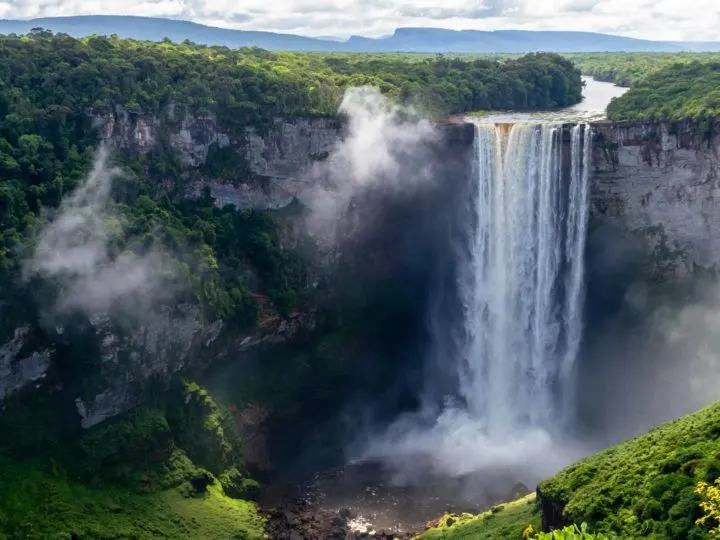
Just east across the border from Angel Falls is Guyana, a spellbinding country yet one that sees fewer tourists than most other countries in South America. If you’re after unspoiled nature far from the tourist hordes, Kaieteur Falls is just the ticket.
Kaieteur may not be as famous as some other names on this list, but it is in fact the world’s highest single-drop waterfall in the world. It’s a truly spectacular sight, made more so by the dense jungle surrounding it, which hides rare wildlife including the tangerine-coloured Guianan cock-of-the-rock.
4. Tequendama Falls
- Height: 132 metres (433 feet)
- Location: Just south of Bogota, Colombia
- Closest city: Bogota, Colombia
- Best time to visit: March through May or September through November, when water volume is highest.
- How to visit: Tequendama is easily reached by local bus (one hour) or rental car (45 minutes) from Bogota.
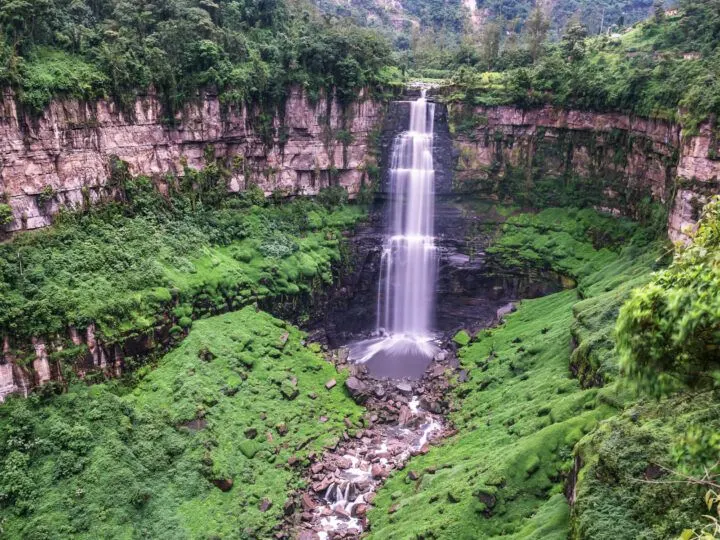
Just outside Bogota lies arguably the country’s most iconic waterfall. Tequendama Falls (Salto del Tequendama) tumbles over a forested cliff just outside the city limits. Since it is just off the road from Bogota, it is one of the most accessible waterfalls in Colombia and a perfect stop along any Colombian travel itinerary.
Although it’s not possible to climb to the top or bottom of the falls, there are great views from the trail alongside the cliff, and from the stately old mansion housing the Tequendama Museum.
5. El Pailón del Diablo
- Height: 80 metres (262 feet)
- Location: Tungurahua Province, central Ecuador
- Closest city: Ambato, Ecuador
- Best time to visit: Consistent rainfall makes this waterfall a year-round destination.
- How to visit: Ambato is a three and a half-hour bus ride from the capital, Quito. From Ambato, the falls are another hour by bus.
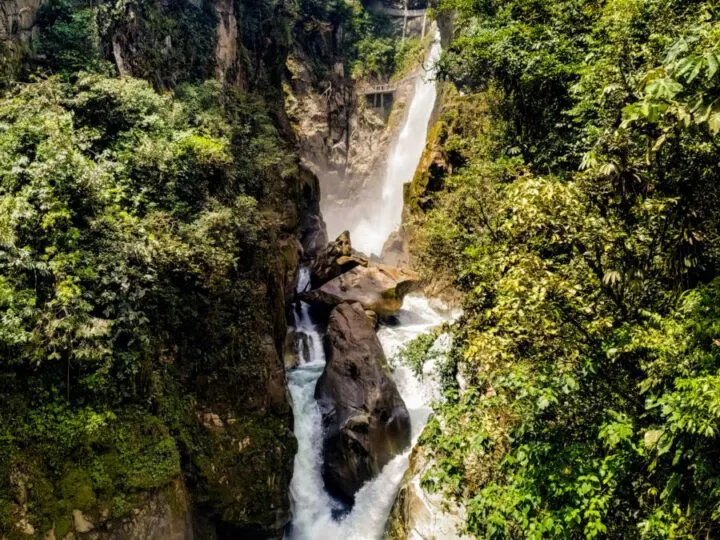
Journeying south, El Pailón del Diablo (The Devil’s Cauldron) is a thunderous waterfall set in a densely forested canyon spanned by a rope bridge. Carved into the canyon is a well-maintained stairway, making the falls easily accessible. This stairway leads from the top of the falls to the bottom, giving you magnificent views as you climb.
6. Gocta Falls
- Height: 770 metres (2526 feet)
- Location: Amazonas Department, northern Peru
- Closest city: Chachapoyas, Peru
- Best time to visit: May and June, at the tail end of the rainy season when water volume is high but the trails are less treacherous.
- How to visit: Chachapoyas is reached by flight or sleeper bus from Lima. The trailhead is in the village of Cocachimba, an hour colectivo ride north from Chachapoyas. The hike to the falls is around three hours. You can return to the highway by another trail to San Pedro, making a circuit.
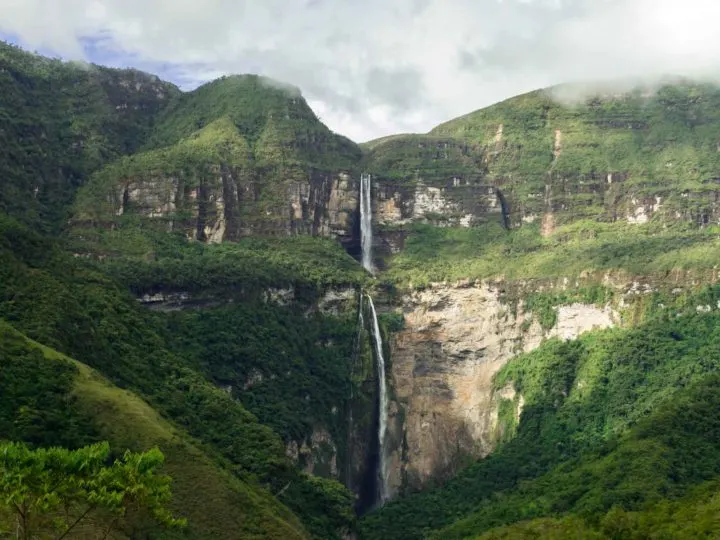
Across the border in northern Peru is Gocta Falls, one of the most spectacular waterfalls in northern Peru. The water rushes down in two long cascades amidst a lush cloud forest. The area possesses an astounding range of flora and fauna, including orchids, agave, parrots, hummingbirds, woolly monkeys and spectacled bears.
7. Yumbilla Falls
- Height: 896 metres (2939 feet)
- Location: Amazonas Department, northern Peru
- Closest city: Chachapoyas, Peru
- Best time to visit: May and June, at the tail end of the rainy season when water volume is high but the trails are less treacherous.
- How to visit: A colectivo from Chachapoyas will drop you off in the town of Pedro Ruiz, from where moto-taxis take you the half-hour to the village of Cuispes. The hike from here to the falls is an hour and a half.
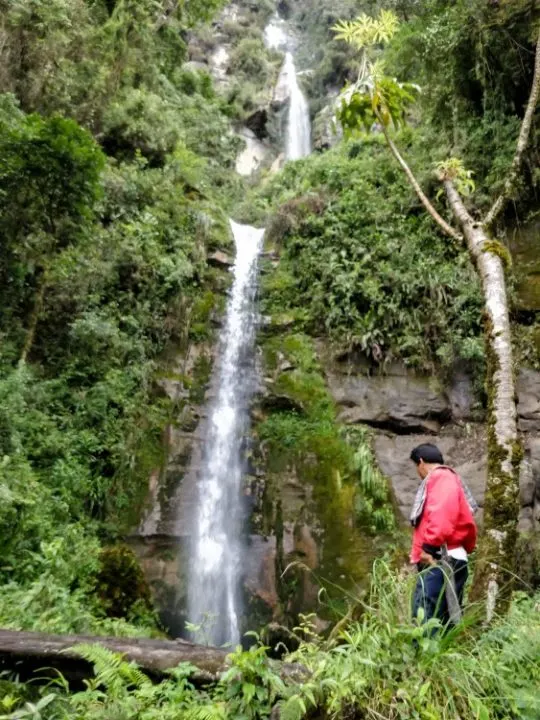
Not far north from Gocta Falls is one of the biggest waterfalls in South America, Yumbilla Falls. At 896 metres, the five drops that make up this waterfall are actually higher than Gocta, and can be viewed from various different vantage points along the five-kilometre trail that strikes out from the tiny village of Cuispes and cuts through the jungle.
Much less visited than neighbouring Gocta, these falls aren’t quite as spectacular, but are empty of visitors and an adventure to reach.
8. Rainbow Falls
- Height: 88 metres (289 feet)
- Location: Noel Kempf National Park, near the border with Brazil in eastern Bolivia
- Closest city: Santa Cruz, Bolivia
- Best time to visit: March through May, at the end of the rainy season when water volume is highest.
- How to visit: The park and falls are accessed by charter plane from Santa Cruz. The flight is an hour and a half.
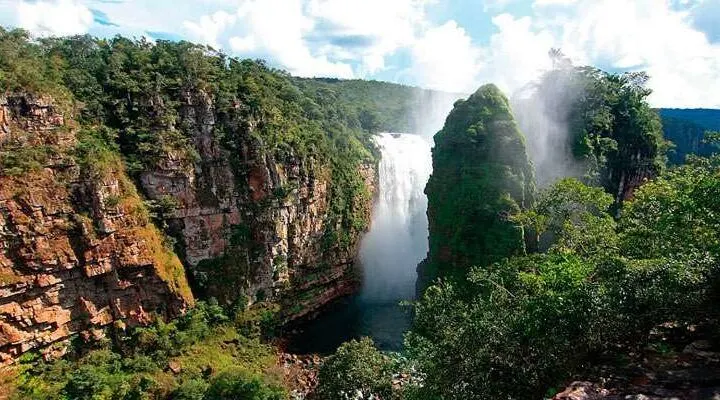
In Bolivia near the border with Brazil are the magnificent Rainbow Falls (Cascada Arco Iris). While quite remote and a challenge to approach, this waterfall is a sight to behold. Set just behind a pillar-like limestone outcropping, these falls are often crowned with a rainbow.
Visitors must book with a government-approved tour company. We recommend Amboro Tours, who operate out of Santa Cruz.
9. Cachoeira da Fumaça
- Height: 340 metres (1115 feet)
- Location: Chapada Diamantina National Park, northeastern Brazil
- Closest city: Salvador, Brazil
- Best time to visit: November through April for highest water volume, or May through October to see the ‘smoking’ cascade.
- How to visit: Local buses travel the five to six hours from Salvador to Lençóis. Alternatively, hiring a car is a good option for independent travellers. From there it’s a two- to three-hour hike southwest of town to the top of the falls. To reach the bottom, it’s a three-day trek from Lençóis.
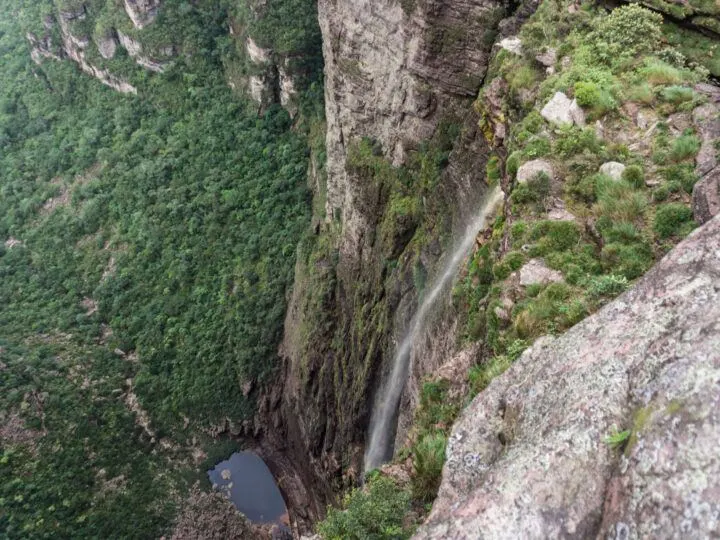
Located in eastern Brazil, Cachoeira da Fumaça (Smoke Falls) is a spectacular waterfall where strong winds turn the gush of water into a cloud of mist, giving it a “smoking” appearance.
In the dry season, the diminished torrent turns into vapour before reaching the bottom, adding to the atmospheric appearance of these falls, which crash down from a high cliff set in the Chapada Diamantina National Park.
10. Juncal Falls
- Height: 9 metres (30 feet)
- Location: The Atacama Desert, northern Chile
- Closest city: Copiapó, Chile
- Best time to visit: June through August, when the falls are frozen in the winter.
- How to visit: Flights from Santiago arrive at Chamonate Airport, near Copiapó. There is no public transport to the falls, so it’s best to either rent a 4×4 vehicle in Copiapó or arrange a tour with private transfer.

In the southern end of the Atacama Desert in Chile you’ll find an unusual natural spectacle: a waterfall in the driest non-polar desert on Earth. Between the months of June and September during the austral winter, the Juncal Falls freeze solid – which explains why this remote waterfall is also known as the Cascada Congelada (Frozen Falls).
Set far out into the desert, these falls are a true adventure to reach and conditions can be cold when you get there; wear plenty of layers to protect you from the howling winds found here in winter. After viewing the falls, head to the nearby Termas de Juncal, natural hot springs that will warm you back up again.
11. Petrohué Falls
- Height: 5 metres tall (16 feet)
- Location: Vicente Pérez Rosales National Park, southern Chile
- Closest city: Puerto Montt, Chile
- Best time to visit: September through November, when water volume is highest.
- How to visit: Flights connect Santiago with Puerto Montt. Public buses pass by the falls, but a private tour or rental car are the most convenient means of arrival.
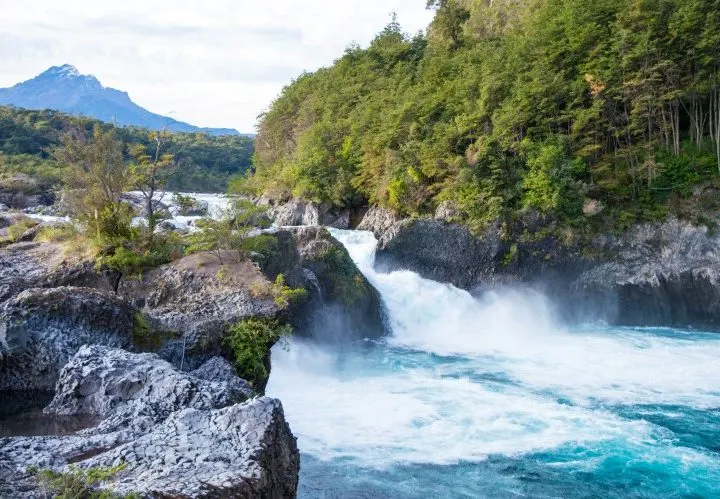
In the Lakes Region of southern Chile, there’s plenty of water, so it’s no surprise that the Petrohué Falls (Saltos del Petrohué) make this list. While not very high, these falls are dramatic, rushing through polished back basalt rock in a rumble and rumble of water, while the perfectly conical peak of the Osorno Volcano in the background gives them a majestic quality
In the spring months, the river swells with melted snow from the Andes, giving the falls an icy blue hue.
12. Salto Grande
- Height: 15 metres (49 feet)
- Location: Torres del Paine National Park, Chilean Patagonia
- Closest city: Puerto Natales, Chile
- Best time to visit: Salto Grande is a year-round destination, but many choose to avoid peak season crowds from November to March. Water volume is at its highest from September through November.
- How to visit: Flights connect Santiago with Puerto Natales, from where it’s a three-hour bus ride to Pudeto. Salto Grande is a fifteen-minute walk from Pudeto.

Lying within the magnificent Patagonian landscapes of Chile’s landmark national park, Torres del Paine, is the beautiful Salto Grande (Large Waterfall). Part of the appeal of these falls is their backdrop: breathtaking views of the Cordillera del Paine, the mountain range that dominates the national park and draws hikers in their droves, lies beyond.
While the Salto Grande might not be the biggest or the most dramatic waterfall on this list, a visit to Patagonia’s most famous national park would be incomplete without seeing these icy blue falls.
13. Cascada Los Amigos
- Height: 9 metres (29 feet)
- Location: Tierra del Fuego, Argentine Patagonia
- Closest city: Ushuaía, Argentina
- Best time to visit: June through August for the frozen waterfall, or September through November for the highest water volume.
- How to visit: Ushuaía is connected by flight to both Buenos Aires and Santiago, Chile. The waterfall is a ten-kilometre walk from Ushuaía.
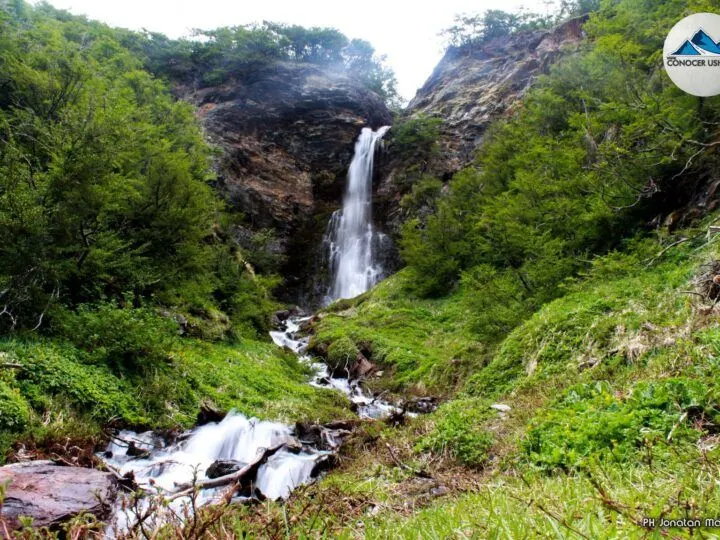
At the very end of the continent on the southern tip of Tierra del Fuego is Cascada Los Amigos (Friends Falls). A wonderful year-round destination, these falls often freeze solid during the winter, but during summer and spring, you’ll find them gushing dramatically down a cliffside, and pouring into a narrow stream that drains into the Beagle Channel.
Easily accessible from Ushuaía, these falls are reached by a short but scenic hike, which offers superb views of the surrounding mountains, glaciers and the Beagle Channel beyond.
